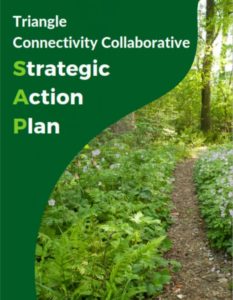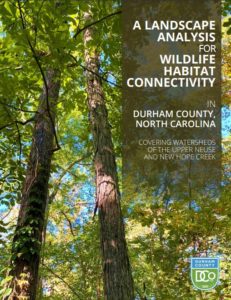Resources
The Triangle Connectivity Collaborative Strategic Action Plan 2023 outlines the priority actions needed to conserve and restore habitat connectivity for wildlife in the Upper Neuse and New Hope Creek watersheds. It was developed through a stakeholder process representing conservation groups, local governments, state and regional transportation planning organizations, universities, and ecologists. The Strategic Action Plan was funded through the Network for Landscape Conservation’s Catalyst Fund.
The Durham County Open Space Program led an update of the previous habitat network analysis., as described in A Landscape Analysis for Wildlife Habitat Connectivity in Durham County, NC. They partnered with Triangle Connectivity Collaborative members to expand the analysis to include watersheds of the Upper Neuse and New Hope Creek, thus providing coverage for all of Durham County and most of Orange County, as well as portions of Wake, Granville, Person, and Chatham counties. This analysis is detailed in the report. It also contains information on the vital role that connectivity conservation plays in sustaining ecosystems and in supporting communities. Funding was provided by Burt’s Bees.
The Eno-New Hope Landscape Conservation Plan was the first effort of the Triangle Connectivity Collaborative to understand habitat connectivity needs and opportunities in the Eno and New Hope Creek watersheds. The plan describes the critical importance of habitat connectivity for wildlife in the Eno River and New Hope Creek watersheds in Chatham, Durham, Orange and Wake counties. It also summarizes relevant local planning documents in support of habitat connectivity. It was produced by a collaboration among local governments, conservation groups, universities, and ecologists. The plan is a Partners for Green Growth project funded by the North Carolina Wildlife Resources Commission and Orange County, NC, and administered by the North Carolina Botanical Garden Foundation, Inc.
Partner Efforts
The Triangle West Transportation Planning Organization (TWPTO, formerly the Durham-Chapel Hill-Carrboro Metropolitan Planning Organization) worked with Triangle Connectivity Collaborative members, especially the Transportation Working Group, to identify and assess priority road infrastructure projects to support wildlife passage. This plan was adopted by TWTPO in 2024.
In 2021, the Durham County Open Space Program | Durham County (dconc.gov) contracted with the North Carolina Biodiversity Project to conduct a comprehensive biological survey of the New Hope Creek Corridor. This study involved intense field research to tally species in over a dozen taxonomic groups—everything from birds, mammals, and plants to fungi, lichen, and slime molds. Their report is a remarkable achievement. It describes a diverse ecosystem kept healthy by decades of concerted conservation efforts, a landscape home to rare plants, intriguing animals, and—possibly—organisms previously unknown to science. It unflinchingly documents the pressures that threaten the New Hope Creek Corridor and details what must be done to keep them at bay. Finally, in its scope, its methods, and its recommendations, it is an invaluable contribution not only to the protection of the New Hope Creek ecosystem, but to conservation science as a whole.
Survey efforts and report were funded through a grant from the Burt’s Bees Foundation.
Green Growth Toolbox
The Green Growth Toolbox is a technical assistance program led by the N.C. Wildlife Resources Commission. It is designed to help communities conserve high quality connected habitats as communities and developers continue to build new homes, workplaces, and shopping centers. The toolbox helps communities plan for growth in a way that will conserve your natural assets—fish, wildlife, plants, streams, forests, fields, and wetlands.


